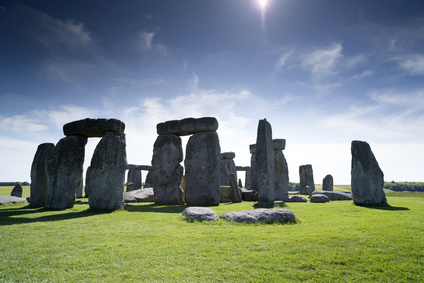Stonehenge in Wiltshire forms part of a World Heritage Site, along with other monuments in Avebury and the surrounding area. The site is made up Sarsen stone, Bluestone and Welsh Sandstone as is estimated to have begun construction as early as 3100 BC for use in Solar and Lunar worship among other ceremonies.
A visit to site includes not only a walk around the stones, but also:
- Access to replica Neolithic houses,
- The challenge to try and pull a Bluestone (not one from the site, one taken from the mountains specially for the challenge!)
- Access to three exhibitions: Standing in the Stones, Soldiers of Stonehenge and The Stonehenge Exhibition.
- A walk around the ancient landscape.
- An audio guide and guidebook can be purchased separately and there is access to a café and giftshop.
A beautiful place to enjoy a sunset (especially if you can find the right place to stand, where the sun is framed by the stones as it sets), Stonehenge is even more breath-taking if you are lucky enough to be able to witness the Summer or Winter Solstice celebrations. During these celebrations, the original purpose from all those thousands of years ago suddenly seems crystal clear.
Even without the Solstice celebrations, taking time to wander the circumference of the stones is a magical experience (particularly if you manage to go at a fairly quiet time with less people around). It’s heart-breaking to realise that no matter how much we try to conserve this incredible monument, we can’t beat Mother Nature and one day the stones will fall and be reclaimed by the earth. For the time that they remain, however, it’s worth every penny and every moment you can spend enjoying their energy and the 5000 years of history they have seen. A symbol of endurance and strength, Stonehenge stands with as much of the adoration and importance now as it did for our ancestors.
Below is a brief history of Stonehenge. If you want to skip straight to the details, however, here is the official website and some Visitor information:
http://www.english-heritage.org.uk/visit/places/stonehenge/
- Visits must be booked in advance due to a cap on visitor numbers to protect the land.
- The last admittance is two hours before the advertised closing time.
- Tickets are available with or without Gift-Aid and include family, disabled and elderly concessions. You can also become a member of English Heritage and pay a set yearly fee to visit as many English Heritage sites as you like, all around the country, for free.
Stonehenge: A Brief History.
The first stage would have consisted of an earthwork Henge complete with an earth bank, ditch and Aubrey holes; one meter in diameter and depth, these pits would have formed a circle of around 284 feet in circumference. It is due to these Aubrey Holes that a wide area around the stones has been cordoned off; the ground around the monument is now unstable and even a few people walking around could cause the earth to slip.
During the second phase of construction (around 2150 BC), 82 Bluestones were gathered from the Preseli Mountains in Wales and transported 240 miles to the Henge site. Once they had made their incredible journey, they were positioned in an incomplete double circle and the entrance to the original earthwork circle was widened, with a pair of Heel stones put up.
Around 2000 BC the third stage of construction began with the arrival of the Sarsen stones from the Marlborough Down near Avebury. These were used to form the outer circle, whilst inside the circle five trilithons were arranged in a horseshoe shape; the remains of which can still be seen today.
The final stage of construction happened around 1500 BC and involved the Bluestones being re-arranged into the horseshoe and circle shapes that can be seen today. It is believed that originally there would have been around 60 Bluestones in the arrangement, but over time the majority have been moved, used in other structures or destroyed. Ordinance has shown there are still a few stumps below ground level.





